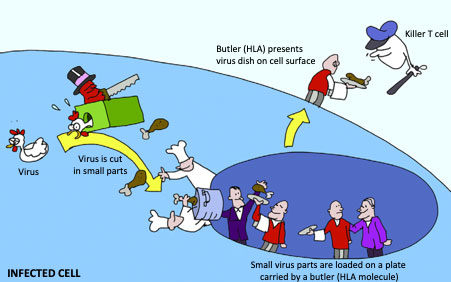06 Dec 2019
Presenting a moving virus dish to hungry killer T cells
Dr Carolien van de Sandt and Dr Bridie Clemens, postdoctoral researchers in the Kedzierska Laboratory have published this fantastic research on influenza severity in Nature Communications.
Check out this fun and informative explanation of the project in Carolien's own words.
The severity of influenza disease, from mild infections to bed bound, hospitalised or fatal outcomes, depends on several viral and host factors.
One of the main determinants is the ability of our immune system to recognise and eliminate the virus.
The Kedzierska Laboratory is especially interested in the killer T cells. These killer T cells recognise infected cells and kill them before they make more viruses, making you feel less sick, and importantly, survive!
However, influenza viruses, in smaller parts called peptides, need to be presented to killer T cells by HLA molecules. HLAs are basically butlers which present dishes of small virus parts on the surface of infected cells so they can be recognised by hungry killer T cells (Figure below from Rocks et al, Present Yourself! By MHC Class I and MHC Class II Molecules, 2016, Trends in Immunology, 2016 Nov; 37(11):724-737.).
When a killer T cell recognises the ‘virus-dish’ presented by the HLA-butler, it grabs the dish which then activates the killing mechanism.
There are numerous different HLA molecules that present different parts of the virus (different butlers serving different dishes), and each of us had four different HLAs (butlers) to serve these virus-dishes to our killer T cells.
According to the published evidence, people who express a butler called HLA-A*68:01 had a higher risk for severe influenza disease during the 2009 influenza pandemic.
Our study shows that the HLA-A*68:01 butler presents an unusually big viral peptide, basically instead of a chicken leg, it presents the majority of a chicken.
What is more important is that the chicken is moving on the plate. This makes it very hard for the killer T cells to grab the virus part and kill the infected cell.
Our research shows that 65 per cent of the individuals who have these HLA-A*68:01 butlers the killer T cells are unable to grab this virus part presented by HLA-A*68:01 (the moving chicken dish).
This has two important implications. First, it shows that people who express these HLA-A*68:01 molecules have a less effective killer T cell response, which explains why this group was at higher risk for severe disease during the 2009 pandemic.
Secondly, the fact that the killer T cells of the remaining 35 per cent of the individuals were able to get a hold on this virus part presented by HLA-A*68:01 indicates that you can potentially ‘train’ your killer T cells to grab the virus part presented by HLA-A*68:01 by repeated exposure, or with a novel vaccine that helps train the killer T cells.

Rocks et al, Present Yourself! By MHC Class I and MHC Class II Molecules, 2016, Trends in Immunology, 2016 Nov; 37(11):724-737.


